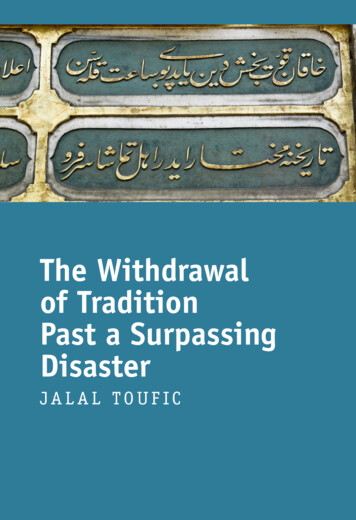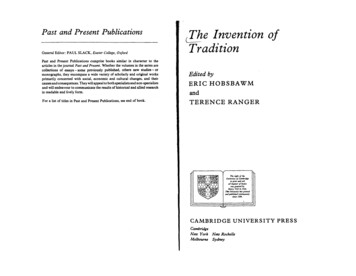
Transcription
The Withdrawalof TraditionPast a SurpassingDisasterJALAL TOUFIC
The Withdrawal of TraditionPast a Surpassing Disaster
Toufic, Jalal.The withdrawal of tradition past a surpassing disaster / Jalal TouficIncludes bibliographical references.ISBN: 978-9953-0-1492-0 2009 by Jalal TouficAll rights reservedThose who wish to have a print version of this book (under a differentimprint and with a different design) are advised to purchase the multivolume publication that accompanies Walid Raad’s exhibition Scratchingon Things I Could Disavow: A History of Modern and ContemporaryArt in the Arab World / Part I Volume 1 Chapter 1 (Beirut: 1992-2005),ed. Clara Kim (Los Angeles: California Institute of the Arts/REDCAT,2009): The Withdrawal of Tradition Past a Surpassing Disaster is one ofthe volumes.Designed by Hatem ImamThe Withdrawal of TraditionPast a Surpassing DisasterJalal TouficForthcoming Books
Books by Jalal Toufic– Undeserving Lebanon (Forthcoming Books, 2007; availablefor download as a PDF file at http://www.jalaltoufic.com/publications.htm)– ‘Āshūrā’: This Blood Spilled in My Veins (Forthcoming Books,2005)– Two or Three Things I’m Dying to Tell You (Post-Apollo, 2005)– Undying Love, or Love Dies (Post-Apollo, 2002)– Forthcoming (Atelos, 2000)– Over-Sensitivity (Sun & Moon Press, 1996)– (Vampires): An Uneasy Essay on the Undead in Film (revisedand expanded edition, Post-Apollo, 2003)– Distracted (2nd edition, Tuumba, 2003)Contents– Credits Included 11– Forthcoming 34– Lebanese Photography Between Radical Closure andSurpassing Disaster 71– Resurrecting the Arab Apocalypse STOP [THE WORLD] 78– Q and A 80– Textual Notes 85– Visual Notes 105
“Credits Included” is a revised version of the essay by thesame title in Jalal Toufic, Over-Sensitivity (Sun & Moon Press,1996); “Forthcoming” is a section of Jalal Toufic, Forthcoming(Berkeley, CA: Atelos, 2000), 60-75; “Lebanese PhotographyBetween Radical Closure and Surpassing Disaster” is a sectionof Jalal Toufic, Distracted, 2nd ed. (Berkeley, CA: Tuumba Press,2003), 80-92; “Resurrecting the Arab Apocalypse STOP [THEWORLD]” is a section of Jalal Toufic, Undeserving Lebanon(Forthcoming Books, 2007), 89-91.
Credits IncludedDedicated to Walid Raad1The section that follows complements my video by the same title: itseems that just as multimedia becomes prominent, we will witnessin some experimental works a separation that will not be (just)between the sound track and the image track, but (also) between theaudiovisual work and the written section, the latter two distancednot only spatially, but also temporally, since a considerable timemay elapse between the broadcast or screening of the one and thepublication of the other.2From a notebook of Mustafa Kemal: two pages of the text of his openingspeech at the inaugural meeting of the 8th parliamentary year of the TurkishGrand National Assembly.If the atomic bombings of Hiroshima and Nagasaki on August 6and 9, 1945, respectively, are a surpassing disaster then beyondnot only the immediate death toll and the manifest destruction ofbuildings, including museums, libraries and temples, and of variousother sorts of physical records, but also the long-term hiddenmaterial effects, in cells that have been affected with radioactivityin the “depth” of the body, and the latent traumatic effects thatmay manifest themselves après coup, there would be an additionalimmaterial withdrawal of literary, philosophical and thoughtfultexts as well as of certain films, videos, and musical works,notwithstanding that copies of these continue to be physicallyavailable; of paintings and buildings that were not physicallydestroyed; of spiritual guides; and of the holiness/specialness ofcertain spaces. In other words, whether a disaster is a surpassingone (for a community—defined by its sensibility to the immaterial11
withdrawal that results from such a disaster) cannot be ascertainedby the number of casualties, the intensity of psychic traumas andthe extent of material damage, but by whether we encounter in itsaftermath symptoms of withdrawal of tradition.3In the case of surpassing disasters, the material loss of manyof the treasures of tradition not only through destruction but alsothrough theft to the victor’s museums is exacerbated by immaterialwithdrawal. Basing themselves on what has been resurrected,some of those who belong to the community of the surpassingdisaster can contest the version of history edited by the victors,who, not being part of the community of the surpassing disaster,have the advantage that the works and documents are available tothem without having to resurrect them.What have we as Arab thinkers, writers, filmmakers, videomakers, painters, musicians, and calligraphers lost after thego to the West because it is there that we can be helped in ourresistance by all that we do not receive in developing countries:7their experimental films and video art, their ontological-hysterictheater, their free improvisation, etc.; and because we can theremeet people who can perceive, read or listen, and genuinely usepre-surpassing-disaster art, literature, music and thought withouthaving to resurrect them. At this juncture in Arab history, JohnBarth, the author of the intricate The Last Voyage of Somebodythe Sailor (1991), is a foreigner to me, an Arab writer, preciselybecause of his proximity to and his ability to use, as if it werecompletely available, A Thousand and One Nights, a book to theother side of the surpassing disaster.8 If, following the devastationof Lebanon, Iraq, Sudan, and earlier of Arab Palestine, etc., I canhave the same close relation with one of the most beautiful booksof the Middle East and North Africa, A Thousand and One Nights,seventeen years of Lebanese civil war; after the Israeli invasion ofLebanon in 1982; after the symptomatic Anfāl operation against theIraqi Kurds; after the devastation of Iraq; and after Ḥāfiẓ al-Asad’sregime’s symptomatic brutal repression of Hama in 1982?4 We havelost tradition5 (we leave it to teachers—with all due disrespect?—topropagate “it.” In the aftermath of the surpassing disaster, traditionis in some cases totally withheld from the thinker and/or artist;in other cases, it is withheld from him or her as a thinker and/orartist, but not as a teacher or historian or a person—is this partlywhy a year after writing the previous words of this paragraph, Ibegan teaching?6). We do not go to the West to be indoctrinatedby their culture, for the imperialism, hegemony of their cultureis nowhere clearer than here in developing countries. Rather, weas Barth and Pasolini (Arabian Nights, 1974) can, then I will knowthat I am either a hypo-critical Arab writer or already a Westernwriter (in the section of Over-Sensitivity [1996], the book in whichthe original version of this essay appeared, on one episode fromA Thousand and One Nights, the latter is accessed and addressedthrough Pasolini’s film).9 Rather than a common language and/or racial origin and/or religion, being equally affected by thesurpassing disaster delimits the community (is it legitimate toconsider the Lebanese as one community when those of them whowere living in East Beirut and other Christian-ruled areas wereimplicated in the desertion of besieged West Beirut during the1982 Israeli invasion of Lebanon?).10Beyond the factor of the language in which one speaks and/1213
or writes, it is in part whether pre-surpassing-disaster tradition isstill available to one irrespective of any resurrection that revealsto one whether one is still part of one’s native culture or whetherone should consider oneself already part of the culture to whichone has emigrated. But for certain musical pieces, books, andminiatures, it appeared that the many disasters that befell theircountries of origin in the Middle East and North Africa completelysevered Arab exiles’ links with these countries and cultures.But this proved not to be the case, for when these countries andcultures were devastated by an additional series of disastersadding up to a surpassing one, these musical pieces, books, andminiatures were immaterially withdrawn even for some of theseexiles—this revealing that these exiles were still attached to thesecountries and cultures and not only to the music, miniatures, andcalligraphy, and now need to resurrect the latter if they desirecollaboration with future thinkers, writers, artists, etc.).14 Wasmy writing my first two books in English (Distracted, 1991, and(Vampires): An Uneasy Essay on the Undead in Film, 1993), booksthus withdrawn from those in the Arab World who are not proficientin English, a symptom of a withdrawal of tradition past one ormore surpassing disasters affecting the Arab World? A translatorwho sets out to translate such a work to Arabic would first have todecide whether writing in English was a symptom of a withdrawalpast a surpassing disaster, for in that case to translate into an Arabicthat does not itself present a withdrawal in relation to Arabs whoare not proficient in English would be a mistranslation.Concerning a surpassing disaster, collateral damage includesmuch of what those who are insensitive to such a disaster view ashaving been spared. A filmmaker, thinker, writer, video maker, ormusician who in relation to a surpassing disaster still considers1415them to be available again. Resurrection takes (and gives) time.11Pending their resurrection, such music pieces can show at most inthe credits; although at no point is Munīr Bashīr’s performance ofMaqām Kurdī heard in my video Credits Included, it is listed in themusic credits.12Although many artists, writers and thinkers are viewed and/or view themselves as avant-garde (for example Nietzsche),13considered to be in advance of their time, when the surpassingdisaster happens their works are withdrawn as a consequence of it,this implying that, unlike the vast majority of living humans, whoare behind their time, artists, writers and thinkers are exactly oftheir time (the future component of their work, which maintains itsrelevance far into the future, comes to them through their untimelythat tradition has persisted, never has the impression that he hasto resurrect even some of what “survived” the carnage; who canask, “Why have I survived and why has this building been sparedwhile so much else was destroyed?” without any suspicion thatthe building in question as well as many books and artworksthat had the good fortune of not being destroyed materially havenonetheless been immaterially withdrawn by the surpassingdisaster, is hypocritical, that is, hypo-critical, still this side of thecritical event of the surpassing disaster.I have to do my best to physically preserve tradition, whileknowing that what I will save physically from the surpassing disasterstill needs to be resurrected—one of the limitations of history as adiscipline is that the material persistence of the documents blinds it
to the exigency of the resurrection. In rare cases, I feel that a film isnot trying to adapt a book to another medium with its own specificparameters and/or to another historical period and hence anothertemporality, but to resurrect it—after the resurrection, it may stillbe in the judgment of some filmmakers in need of adaptationto new contexts. Similarly, remakes are not always to be viewedin terms of adaptation to other times or reparation occasionedby the failure of a filmmaker or video maker to heed his or heruntimely collaborator who happens to be (also) a filmmaker orvideo maker.15 Herzog’s remake of Murnau’s Nosferatu (1922) canbe viewed not so much as a sound and color version of a silentfilm, but rather as an attempt to resurrect Murnau’s film after itswithdrawal following a surpassing disaster, the Nazi period. Inwhich case, there are two ways of considering whether it was asuccessful film: did it succeed as a film irrespective of its relationof the Nazi period, is itself there and not there for the generationfollowing that surpassing disaster. Godard and Herzog, who haveinfluenced many filmmakers, producing, in Vertov’s expression,“films that beget films,” have also produced films that resurrectfilms. In his first films Hal Hartley, who knew then nothing aboutsurpassing disasters, could imitate Godard, while Godard himselfmakes some of his films in the manner of someone who can nolonger access his earlier ones (including his films of the New Wave,as the title of Godard’s film about resurrection, New Wave [1990],implies) as a result of some surpassing disaster(s), for example theone alluded to in his King Lear. One of the surest ways to detectwhether there’s been a surpassing disaster is to see when some ofthe most intuitive and sensitive filmmakers and/or writers and/orthinkers began to feel the need to resurrect what to most others, andto the filmmaker and/or writer and/or thinker himself or herself as1617to Murnau’s Nosferatu? In case it did not, did it nonetheless succeedas a resurrecting film? Nosferatu, one of the nine extant films outof the twenty-one Murnau made, was twice withdrawn: in 1925 itwas withdrawn by court order because it violated the copyright forStoker’s Dracula—copies of it were back in circulation by 1928;past the surpassing disaster of the Nazi period, and although itwas still circulating, it was withdrawn from the filmmakers of thefollowing generation (Herzog: “We are trying in our films to builda thin bridge back to that time”16). Herzog’s Nosferatu: a vampirefilm trying to resurrect an extant film about the undead, about whatsimultaneously is and is not there, as is made clear by the mirrorin which the vampire does not appear notwithstanding that he isstanding in front of it; but which, because of the surpassing disastera person or teacher, i.e., in so far as he or she remains human, alltoo human, is extant and available.Disaster films that are not exploitation ones sometimes includea resurrection of artworks, books of literature, and/or films. InAkira Kurosawa’s Dreams (1990), a section showing the explosionof six nuclear reactors in Japan, the variously-colored radioactivefumes forming an eerie aerial palette resulting in the decimation ofthe population, is followed by a section where the late-twentiethcentury protagonist enters, walks and runs in various Van Goghpaintings; in order to allow his protagonist to do that, Kurosawahad to digitally recreate the paintings (using the services ofIndustrial Light & Magic’s post-production visual effects), andthis recreation functions as a subtle resurrection. In Chris Marker’s
La Jetée (1962), whose events take place for the most part after thenuclear destruction of much of the world, including presumablyChris Marker’s favorite film, Hichcock’s Vertigo (1958), duringthe Third World War, while standing in the company of his femalecompanion in front of a cut tree trunk, the time-traveler to the pastpoints to a spot beyond its perimeter and “hears himself say”: “Icome from here” (how subtle is this hint of quotation [of Vertigo’sMadeleine]!). Should we view this shot as an attempt to resurrectthe shot in Hitchcock’s Vertigo (and by implication the film)17where Madeleine, in the company of Scottie, points to a section ofthe cut trunk of a sequoia tree and says, “Somewhere here I wasborn”? Wim Wenders’ film work, although it includes manyreferences to ends, for example the possible end of the world inUntil the End of the World (1991), and the possible end of cinemain Chambre 666 (1982) (one of the questions he poses to theinterviewed filmmakers is: “Is cinema becoming a deadlanguage?”), nonetheless rarely attempts to resurrect or evincesresurrections. Two possible exceptions: in Tokyo Ga (1985), a filmthat mourns the possible irretrievable loss of the Japan of Ozu, the50-millimeter shot of an alley can be considered a resurrection ofan Ozu shot. In Until the End of the World, the fact that the diegeticwriter’s narration that begins the film, “It was in 1999 ”, andgoes on to relate the events that the film shows, focusing on aspecial camera that allows the blind to see the images it recorded,is part of a novel he began writing after the presumed nuclearconflagration of the (rest of the) world wiped his earlier novel-inprogress off his computer indicates that we are viewing theseprotagonists and events from the post-surpassing-disaster18standpoint and requirements. The blind woman, whom we meet forthe first time after the presumed nuclear conflagration, embodiesthe inclusion in the film of the loss of images and of the attempt toresurrect them: we hear her say jubilantly, “I see a blue a yellow a red ”, as the Vermeer-like shot of her daughter sitting by thewindow and wearing a blue headband and a yellow dress begins toassemble again and become clear (taking into account that, as(Vampires): An Uneasy Essay on the Undead in Film points out, itis dangerous to resurrect if one is alone, felicitously the specialcamera requires for its efficient functioning that simultaneouslywith the blind person whose brain is linked to a computer simulationof the recorded image, the one who originally recorded the imagesee the latter by recall in his/her mind’s eye). In Godard’s Passion(1982), the failure of the diegetic director to finish his film is notto be ascribed to an inability to come up with a story and to attainthe right lighting; rather the inability to tell stories and to producethe right lighting is in this case merely a symptom of his obscurefeeling that he has failed in his unconscious attempt to resurrectwhat has become withdrawn due to a surpassing disaster, whichtask he was trying to accomplish by producing a series of tableauxvivants of either the whole or part of paintings from earliercenturies, for example Delacroix’s The Entry of the Crusaders intoConstantinople (1840). As far as those who commissioned Godardto do a film adaptation of Shakespeare’s King Lear that was to beready in time for the following year’s Cannes Film Festival, theCannon Films producers, Menahem Golan and Yoram Globus,were unconcerned, the play was obviously available. It wasavailable too for the screenwriter, Norman Mailer, for whom “the19
mafia is the only way to do King Lear,” and whom we see finishinghis cinematic script of King Lear at the preliminary section ofGodard’s King Lear (1987). It was also available to the filmmakerGodard, who remarks that he said to Mailer, who at that point wasnot only the screenwriter but was also still contracted to play DonLearo, “Kate [Norman Mailer’s daughter] enters your room andkisses you when she hears you finished the play—not your play,but the play.” But then we hear, over the intertitle “No Thing,” avoice-over: “And then, suddenly, it was the time of Chernobyl,18and everything disappeared, everything, and then, after a while,everything came back, electricity, houses,19 cars—everythingexcept culture and me.” Taking into consideration Godard’s viewthat “culture is the norm, art the exception,” the protagonist lateramends what he said: “I don’t know if I made this clear before, butthis was after Chernobyl. We are in a time now when movies andGiotto’s The Lamentation of the Dead Christ (ca. 1305); works byShakespeare, including King Lear, the play Godard’s film wassupposed to adapt! What about François Truffaut’s films? With thepossible exception of La Femme d’à côté (The Woman Next Door,1981), his films continued to be available past the surpassingdisaster. Is the work of the American theater director Peter Sellars,who plays William Shakespeare Junior the Fifth, including hisproduction of King Lear in 1980 and the Shakespeare plays hedirected while he served as director of the Boston ShakespeareCompany in 1983 and 1984, included in what was withdrawn bythe surpassing disaster mentioned by Godard? No. Were NormanMailer’s books published prior to 1987, as well as his script forGodard’s King Lear, withdrawn past the surpassing disasterannounced by Godard? The script seems not to have beenwithdrawn, so that we end up with a give-and-take where2021more generally art have been lost, do not exist, and must somehowbe reinvented.” What can be included among what was andcontinued to be lost, withdrawn, no longer available even after“everything” came back? Films by Robert Bresson (for examplePickpocket [1959], Au hasard Balthazar [1966], Lancelot of theLake [1974], L’Argent [1983]), Carl Theodor Dreyer (for exampleVampyr [1932], The Passion of Joan of Arc [1928], Ordet [aka TheWord, 1955]), Pier Paolo Pasolini (for example Theorem [1968],Arabian Nights [1974]), Fritz Lang (for example M [1931] and TheTestament of Dr. Mabuse [1933]), Leos Carax (Mauvais sang [TheNight Is Young, 1986]), who plays Edgar in the film; VirginiaWoolf’s book The Waves (1931), a copy of which we see on thebeach in Godard’s film; Van Gogh’s Wheatfield with Crows (1890);Shakespeare’s play is itself withdrawn and requires the resurrectingefforts of William Shakespeare Junior the Fifth, but many linesfrom it are available to the two characters Don Learo (an agingmobster) and his daughter Cordelia through the script Maileradapted from the play, and end up in the resurrected play: “Thanksto the old man’s daughter, I [William Shakespeare Junior the Fifth]had some of the lines.” Taking into consideration the withdrawalof tradition past a surpassing disaster, what is one of the tasks of anartist or a writer? “My task: to recapture what had been lost,starting with the works of my famous ancestor. Oh, by the way,my name is William Shakespeare Junior the Fifth.” According tothe protagonist, he was assisted by a certain Professor Pluggy,played by Godard, whose research, he had been told, was “moving
along parallel lines to” his. Is Godard’s King Lear’s image of thejoining of torn petals back to a dead flower, which resuscitates, acitation of Cocteau’s resurrection of the shredded flower in TheTestament of Orpheus (1960)? Is it an attempt to resurrect theflower? Is it a resurrection of the image of a resurrection of aflower in Cocteau’s film about the undead? It is the latter. Godard’sKing Lear tackles the three tasks of the filmmaker and/or artistand/or thinker and/or writer or and/or video maker concerning asurpassing disaster: 1) to reveal the withdrawal of tradition, andtherefore that a surpassing disaster has happened. King Lear: “Iknow when one is dead and when one lives” (William Shakespeare,King Lear 5.3.260); past surpassing disasters, it is important toknow when something is available, and when it is no longeravailable since withdrawn: the play, which is ostensibly availableto the producers of the film and to its screenwriter, Norman Mailer,of contemporaries to prevent the imminent surpassing disasterfrom happening.We have to distinguish between on one side quotation, remake,“repetition” of oneself, and, on the other side of the surpassingdisaster, resurrection. Sometimes, one accuses some filmmakers,writers and artists—indeed they themselves sometimes voice theapprehensive self-accusation (for example, Wenders in his Notebookon Cities and Clothes, 1989)—that they may be beginning to“repeat” themselves. In some cases, they are indeed beginning to“repeat” themselves (Wenders’ Notebook on Cities and Clothes);but in some other cases, they are actually attempting to resurrecttheir work and art in general following a surpassing disaster, onewhich may be explicitly invoked in their films or their interviews.Past a surpassing disaster, and taking into account the withdrawalof tradition, as a historian and archivist of myself, I can imitate2223is no longer available to the community of the surpassing disaster;2) to resurrect what has been withdrawn by the surpassing disaster,which is the task assigned to the protagonist, a descendant ofWilliam Shakespeare, who rediscovers Hamlet’s “to be, or not tobe” while in Denmark, and manages to rediscover 99% of, if notthe complete King Lear—yes, past the surpassing disaster, “theimage will appear in a time of resurrection” (these words areattributed by Professor Pluggy to St. Paul); 3) and, in some ominousperiods, to imply symptomatically by the timing of the film that asurpassing disaster is being prepared in scientific experiments invarious laboratories and/or by governmental and/or nongovernmental covert operations, etc., thus functioning as analarming implicit appeal for thoughtful intervention by the minoritymyself, “repeat” myself, but as a filmmaker I cannot do so even ifI wished since my previous work is no longer available—I have toresurrect it before being able to “repeat” myself. Preservation of anartistic film that was made prior to a surpassing disaster requires notonly the actual conservation of the filmstrip in excellent condition,without deterioration of color, etc., but also the resurrection of thefilm. The surpassing disaster alluded to or explicitly presented ina film may remain just part of the latter’s diegesis or it may reachbeyond the diegesis to the film itself or to a previous film or filmsor paintings, with the consequence that the spectators may thenwitness, as a countermeasure to the withdrawal, the apparitionof resurrected images in the film. In Tarkovsky’s last film, TheSacrifice, the shot of the bedroom curtain flapping in the wind
and modulating the light while the child sleeps is reminiscentof the scene in the hotel room in Nostalgia in which the advent,change in intensity, and then stopping of rainfall alter the lightcoming through the windows. Later, those gathered to celebrateAlexander’s birthday hear warplanes flying overhead, experiencean unexpected power failure, discover that the phone is inoperative,then are informed by a radio announcement of the imminent threatof a nuclear disaster. Alexander prays to God, vowing that if theworld is spared, he would willfully lose everything: his family, house When following his vow and the “averted” disaster, Alexanderreturns to his child’s room with its lightly-flapping curtains, I feelthat there is “repetition” neither of the scene in Nostalgia nor ofthe shot’s earlier appearance in The Sacrifice, but rather that weare watching the latter shot’s resurrection. A beautiful differentialcoexistence of “repetition” and resurrection within the same film:to one side of the surpassing disaster, unfortunate “repetition” bythe filmmaker of a shot from one of his previous films; to the otherside of the surpassing disaster, a resurrection of a shot from thesame film. Untowardly, after filming that shot as a resurrectedone, Tarkovsky got sidetracked from the surpassing disaster by thescript—the script should be delimited by the surpassing disaster.Nonetheless, in The Sacrifice, a sort of answer of the real made thecamera break down in the middle of the shot in which Alexandersets fire to the house, leaving Tarkovsky with both an unusable shotand the burned-to-the-ground house (one more unusable celluloidstrip in a film of the surpassing disaster, to join the one on the floorof the editing suite over which the protagonist crashes in Godard’sKing Lear). Tarkovsky accompanied his character not just throughidentification and empathy,20 but also through this parapraxis21,22confirming that even though the house still stood there, it waswithdrawn and had to be resurrected in order for it to be availablefor the shot of its burning by the protagonist. Past the surpassingdisaster, Tarkovsky had to rebuild an exact copy of the house inorder to film its burning, and this time he used two cameras tocover the event. A filmmaker who had contributed to renderingvisible in his films Solaris (1972) and Andrei Rublev (1966)respectively instances of what was otherwise either invisible, theworld of Stanisław Lem’s science fiction novel Solaris, or for themost part no longer visible, fifteenth-century Russia, had then todeal, in The Sacrifice, with what was materially present, the house,as unavailable to perception expect through a resurrection. Whereasin other Tarkovsky films an unworldly version of something that isno longer there sometimes repeatedly irrupts in a radical closure,for example Hari in Solaris, in The Sacrifice what is materially stillthere is immaterially withdrawn as a consequence of a surpassingdisaster (that was seemingly averted). In this film which beginswith Alexander planting a dry tree trunk in the sand and telling hislittle son about a monk who for three years daily watered a dead,dry tree until it blossomed again, and ends with the small childcarrying two heavy buckets of water to the tree and watering it,Tarkovsky resurrects one of his shots and the house. Here cinemadeconstructs what it ostensibly usually does, preserve what isdisappearing (Bazin), what is withdrawing into the past: it showsus the withdrawal of what it preserved from disappearing (into thepast).Any building that was not razed to the ground during the2425
surpassing disaster, materially subsisting in some manner; butwas immaterially withdrawn by the surpassing disaster; andthen had the fortune of being resurrected by artists, writers, andthinkers is a monument. Therefore, while many buildings that wereconsidered monuments of the culture in question are revealed bytheir availability, without resurrection, past the surpassing disasteras not monuments at all of that culture, other buildings, generallyviewed as indifferent, are revealed by their withdrawal to bemonuments of that culture.It is highly likely that the artworks and literary and thoughtfultexts that, past a surpassing disaster, imply the withdrawal of otherartworks and literary and thoughtful texts; and/or the messianicmovements that, past a surpassing disaster, reveal the withdrawalof the religious dispensation and law would have themselves beenwithdrawn past the surpassing disaster had they existed when itmanners of looking at Sherrie Levine’s (re)photographs of the workof other photographers, for example “After Walker Evans,” 1981(the Evans photograph dates from 1936)
completely available, A Thousand and One Nights, a book to the other side of the surpassing disaster.8 If, following the devastation of Lebanon, Iraq, Sudan, and earlier of Arab Palestine, etc., I can have the same close relation with one of the most beautiful books of the Middle East and North Africa, A Thousand and One Nights,











